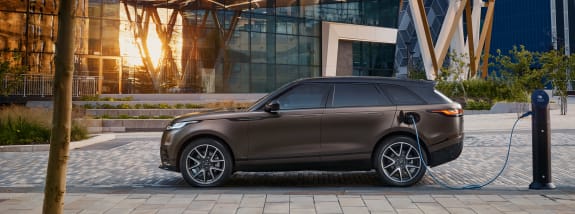Guide to Battery Electric Vehicles (BEV)
100% electric vehicles are the future of UK motoring. Are you ready to make the leap? Find out how they work, pros and cons, special offers...

Welcome to our page dedicated entirely to the Plug-in Hybrid Electric Vehicle, more commonly referred to as a 'PHEV'.
It's a growing segment in the world of electric motoring. Not sure what a PHEV is? Read on to discover if this type of EV could be your next car...
Get a quick overview of PHEVs in 6 easy steps:
Being a 'hybrid' vehicle, a PHEV has both a petrol/diesel engine and a medium-sized battery.
On average, PHEVs can be driven about 30 miles on battery power alone, though some newer models offer longer range.
Once the battery runs out of charge, the petrol/diesel engine takes over for the rest of your journey.
A PHEV has a charging socket which means it can be plugged in to charge its battery. This allows you to access cheap electricity and lower the cost of your motoring.
PHEVs have both a battery range and a petrol/diesel range.
Depending on which model you lease, battery range is typically 25-35 miles, but can be as much as 50-60 miles with the latest, bigger battery models.
When the battery has discharged all of its energy, the petrol or diesel engine automatically kicks in, giving you another 250-350 miles of range.
Check out our Range Guide for more details.
To be able to run on battery power – and benefit from cheap electricity – the PHEV driver needs to charge the battery each day.
If you have off-street parking, get a dedicated charging point installed. You can then charge your PHEV's battery overnight and enjoy a full 'tank of electricity' each morning. Charging time from 0-100% varies from 2-4 hours, depending on the model.
If you are on a longer trip and your battery runs out, it's usually not worth stopping to recharge. This is because a PHEV battery generally has a slow recharging rate. Better to continue your trip using the petrol/diesel engine and then recharge the battery fully at home or work at the end of the day.
Some newer cars, like the Land Rover Discovery Sport PHEV, do have relatively fast charging capabilities, and stopping to recharge on a trip is then an option. Go to our EV Charging Guide for the full picture.
Here are guideline monthly running costs for a Kia Niro EV PHEV lease (1.6 GDi PHEV 2 DCT trim), based on 8,000 miles per year (4,000 electric miles + 4,000 petrol miles), 36 month term, 9 months' deposit, and assuming the battery is charged each night at an off-peak rate of 7.5p per kWh:
| Running Costs | Monthly |
| Lease payment | £422.83* |
| Petrol costs | £41.51** |
| Electricity costs | £5.21** |
| Road tax | £0 |
| Insurance (estimate) | £55.73 |
| Total per Month | £525.28 |
*Correct as of 31st March 2025. **Assuming petrol costs £1.366 a litre; petrol engine efficiency of 50 mpg; electric efficiency of 4.8 miles per kWh. Breakdown cover.
Ready to make an enquiry?
Why not phone us now on 0118 3048 688 or email at enquiries@selectcarleasing.co.uk
The effect you have on the environment in a PHEV depends on various factors, including:
If you only drive 30 miles a day and recharge fully each night, your PHEV should mostly run on battery power alone and be fairly 'green'. Little CO2 will be emitted.
On longer trips, you get your 30 miles' environmentally friendly electric driving, but for the remaining miles your car will consume petrol or diesel inside the internal combustion engine, and your emissions will be the same as a conventional petrol or diesel car.
Finally, if you charge your PHEV with electricity generated by renewable energy technologies, e.g. wind, solar, wave or tidal, those electric miles will be as green as they possibly can be. A few UK energy suppliers now offer 100% renewable energy tariffs.
Once you drive a PHEV, and assuming you have off-street parking and get a dedicated charging point installed, your car will be physically connected to your home or office while charging.
You'll notice your monthly electricity bill will be higher, but remember you will be making significant savings for all those electric miles, as electricity is cheaper than petrol or diesel.
To get your electricity bills down again, you can:
Now you've got an overview of the benefits of Plug-in Hybrid Vehicles, why not check out more of our handy EV Guides and our latest Electric & Hybrid lease deals below:
100% electric vehicles are the future of UK motoring. Are you ready to make the leap? Find out how they work, pros and cons, special offers...
These are the hybrids you can't plug in, also known as 'self-charging'. Confused? You're not alone! Our quick guide tells it straight, explains charging, etc.
Get the low-down on the most popular PHEVs in the UK. Read our ever-expanding review section, comparing and contrasting the latest models.
Don't know your kW from your kWh? This short guide cuts through to the essentials, so you can lease the electric car that matches your needs.
Electric vehicles can save you a small fortune on fuel, but only if you charge at the right rate. Read our guide for electricity tariff tips, BEV v. PHEV...
Thinking about electrifying your fleet? Attracted by ultra-low Benefit in Kind rates for EVs? Discover the wide range of financial incentives on offer.